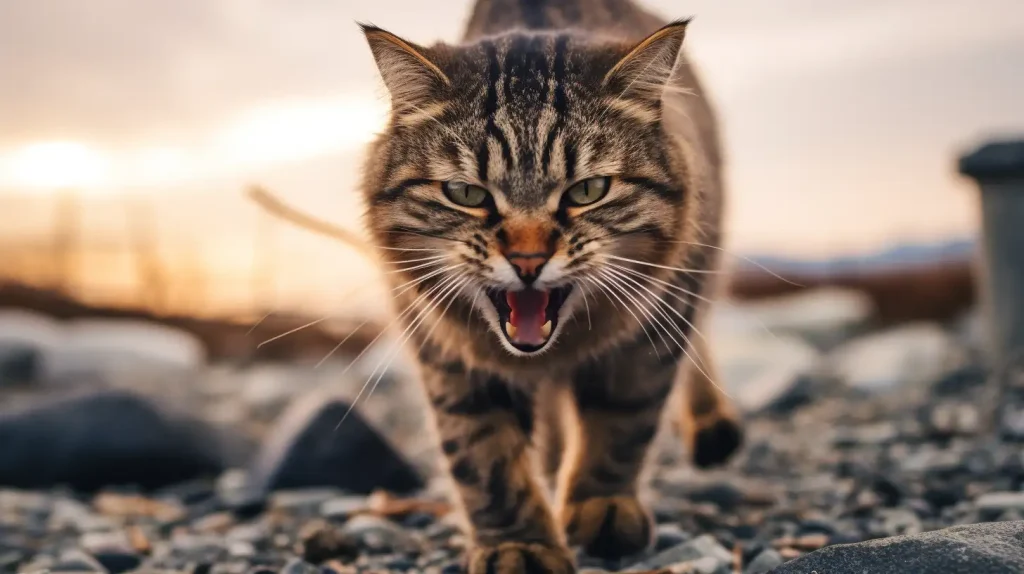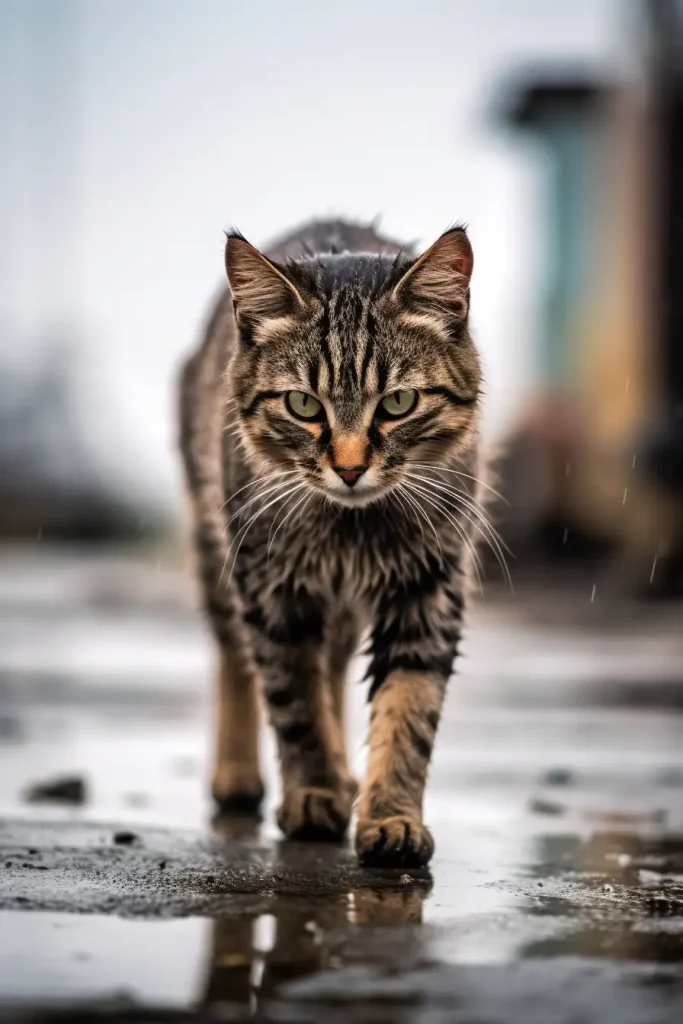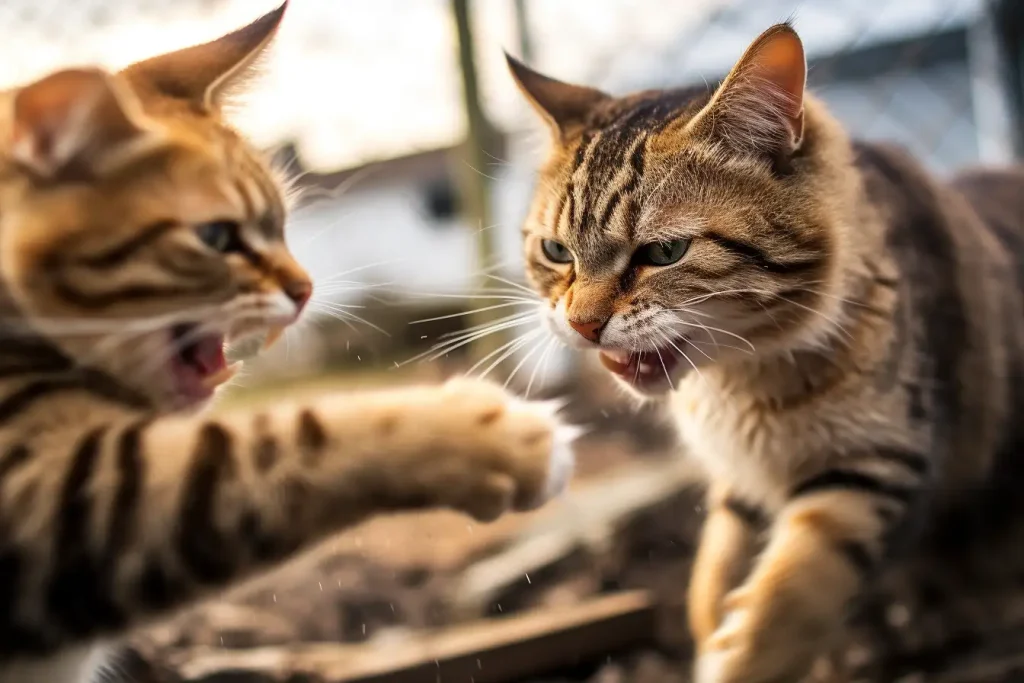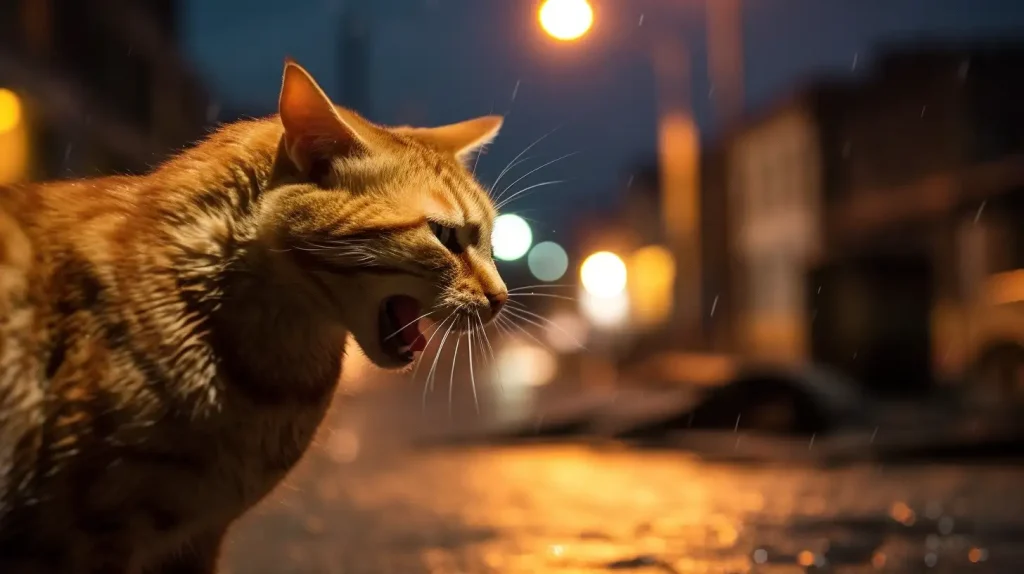Table of Contents
Key Takeaways
- Understanding why do stray cats fight is essential when it comes to their well-being and coexistence with humans.
- Cats’ self-domestication and their ability to adapt to new environments contribute to the existence of stray cats.
- Territorial disputes and resource availability impact stray cats’ behavior and interactions.
- Health issues, seasonal influences, and natural instincts also play a role in stray cat fights.
- Stray cat fights can lead to severe injuries, emphasizing the importance of intervention and informed decisions.
- Animal shelters and rescue organizations play a crucial role in managing stray cat populations and minimizing conflicts.
When walking down the street or looking out your window, you may often see a familiar sight, one that is both saddening and intriguing: stray cats engaged in what seems to be a fierce battle. In the animal kingdom, conflicts are commonplace, and cats are no exception. But have you ever wondered why do stray cats fight? This article will dive deep into the world of stray cats and their intriguing behavioral patterns.
Historical Context
The Domestication of Cats
Have you ever wondered how our pampered house cats came to coexist with humans? To answer this, we must journey back in time to the Near East around 9,500 years ago. Unlike dogs, cats were never intentionally domesticated. As farming societies developed, humans started to store surplus crops. These stockpiles, in turn, attracted rodents. Enter the African wildcat (Felis lybica).
Wildcats naturally prey on rodents, so they were likely drawn to human settlements brimming with pesky rats. Over time, a mutualistic relationship formed: humans appreciated the pest control, and cats enjoyed a consistent food supply. Cats that were more tolerant of humans had better access to this food and thus were more likely to survive and reproduce, kickstarting the process of self-domestication.
From Wildcats to Stray Cats
But how does this relate to the stray cats of today? As cats spread across the globe with human societies, they inevitably faced new environments, challenges, and modes of living. While many cats lived as cherished pets, others found themselves on the streets, either born to stray or feral mothers, or abandoned by their human families.
These street-savvy felines bear a strong resemblance to their wildcat ancestors, not just in their physical characteristics, but also in their behaviors. Like their wildcat forebears, today’s stray cats are territorial, solitary, and fight to protect resources — all survival strategies that have stood the test of time. In understanding the journey from wildcat to housecat to stray cat, we gain a deeper appreciation for the rich tapestry of feline life and the resilience of these fascinating creatures.
Understanding Cat Behavior
To understand why stray cats engage in aggressive behavior, we must first explore the fundamental nature of cats. Unlike dogs, which are social animals, cats tend to be solitary creatures. They are territorial animals, marking their personal space with their scent, and they guard this space fiercely.
Within stray cat colonies, there’s often a complex social structure that humans might find difficult to comprehend. These colonies are typically matriarchal, with a dominant female leading the group. Cats communicate through various methods such as visual cues (like body posture and facial expressions), vocalizations (like meowing, hissing, and growling), and olfactory signals (such as scent marking).
Role of Kittens’ Early Life Experience
Understanding the impact of a kitten’s early life experiences on its future behavior can provide valuable insights into the world of stray cats and their propensity to fight. Just as human children’s formative years have a profound impact on their adult lives, the same can be said for kittens.
During their first few weeks of life, kittens go through a vital socialization period. It’s during this time that they learn to interact with their surroundings, their siblings, and other species, including humans. Kittens who have positive interactions during this period are more likely to grow into sociable, well-adjusted adult cats.
In contrast, kittens that face harsh circumstances such as malnutrition, neglect, or trauma, particularly stray kittens, can grow into adults that are more fearful and defensive. Such cats often perceive the world as a threatening place and may resort to aggressive behaviors, including fighting, as a protective mechanism. This understanding underscores the importance of early intervention, such as fostering and adoption programs, to give kittens a better start in life and potentially decrease aggressive behavior later on.
Influence of Human Activity
The complex dynamics of human-cat interactions play a significant role in shaping stray cat behavior. We often see these feline visitors in our neighborhoods and our first instinct might be to feed them or provide some form of shelter. While these actions are guided by empathy, they can inadvertently influence the behavior of stray cats.
Offering food can draw multiple cats to a single location, which may increase the likelihood of territorial disputes, escalating into fights. Remember, to a cat, food equates to survival, and they may fiercely defend this valuable resource. Furthermore, consistent feeding can lead to an increase in the local stray cat population, as areas with abundant food resources attract more cats.
Providing shelter, though well-intentioned, can lead to similar issues. A cozy spot under a porch or inside a shed can quickly become a contested territory. Additionally, it can become a breeding site, exacerbating the population growth problem.
It’s essential for us, as empathetic human neighbors, to be aware of these potential consequences. If you feel compelled to help, consider supporting local animal welfare organizations that work towards humane management of stray cat populations, such as Trap-Neuter-Return (TNR) programs. These initiatives address the issue at its root, helping to control the population and reduce fights amongst stray cats.

Territoriality and Stray Cats
Territory holds immense importance in a cat’s life. A safe, food-rich territory can make the difference between survival and starvation for a stray cat. Territory quality can greatly impact a stray cat’s behavior and interactions with other cats.
Cats use a variety of markers to signal territorial ownership, including scratching and urine marking. These markers serve as a warning to other cats to stay away and reduce direct confrontations. However, when these boundaries are ignored or overlooked, fights can ensue.
Impact of Urbanization
As our cities and towns continue to grow and spread, we find our lives increasingly intertwined with the animal kingdom, and this includes the world of stray cats. Urbanization significantly alters the landscape, replacing open fields and quiet corners with concrete jungles and bustling streets. For stray cats, these changes can greatly impact their territories and lead to increased conflict. Traditional territories might be replaced by buildings or roads, pushing stray cats into smaller, more condensed areas. This can intensify competition for resources, increase territorial disputes, and inevitably lead to more fights. Additionally, urban environments can provide inconsistent food sources like garbage bins, attracting more cats and increasing the likelihood of fights. But it’s not all gloom and doom. We can co-exist harmoniously with these resilient felines. Simple steps like secure garbage disposal and supporting local TNR programs can make a huge difference. In the end, understanding the impact of urbanization on stray cats can help us create more compassionate communities and reduce the conflicts these animals face.
Reasons for Stray Cats Fighting
Let’s delve into the reasons and answer the question of why do stray cats fight.
Competition for Resources
Stray cats must continuously search for their own food and shelter. When food sources become scarce, or shelter is limited, competition can become fierce, leading to conflicts. Cats, like all animals, have a strong instinct to survive, and when survival is threatened, they can become aggressive to protect their resources.
Mating and Reproduction
In the world of cats, fighting is often a result of reproductive instincts. Male cats will frequently fight over mating rights with females, especially during the breeding season. Unneutered male cats produce a high level of testosterone, which can result in aggressive behavior. On the other hand, female cats in heat can attract multiple males, leading to fights among potential suitors.
Establishment of Social Hierarchy
Within a cat colony, a social hierarchy exists. This hierarchy, often established through fights, helps maintain order within the group. When a new cat attempts to enter an established territory, the resident cats may see this as a threat to their social order, which can lead to aggression and fights.
Disease and Health Factors
Health issues can also contribute to why stray cats fight. An ill or injured cat may become more aggressive due to pain or fear. Furthermore, stress can significantly impact a stray cat’s behavior, with high-stress situations often leading to aggressive responses.
Influence of Season
Believe it or not, the changing of the seasons can greatly influence the behavior of stray cats, particularly their propensity to engage in fights. Cats are known for their keen sense of time, so it’s no surprise that they are sensitive to the shift in weather, daylight hours, and other seasonal changes. In fact, many cat owners and animal welfare observers have noted that there seems to be a peak in cat fights during certain times of the year.
Spring: The Season of Feline Fights
So, when is this peak season for stray cat fights? That would be spring. Why spring, you may ask? Well, it all comes down to biology and natural instincts. Spring is often referred to as “kitten season” in the animal welfare world. This is because cats, like many other animals, have a breeding season which is primarily dictated by the length of daylight hours. As the days get longer, female cats come into heat, attracting the attention of male cats and, unfortunately, leading to an uptick in disputes and altercations among potential suitors.
But it’s not just about mating. The warmer weather and longer daylight hours of spring also mean cats are more active and spend more time exploring, leading to increased chances of territorial disputes.
By understanding these seasonal influences, we can better anticipate the times when stray cats may need extra care and attention, and potentially help to mitigate some of these springtime squabbles.
Impact of Age and Size
In the world of stray cats, both age and size play significant roles in the frequency and intensity of fights. Younger cats, brimming with youthful vigor and the need to assert themselves, might engage in fights more often as they seek to establish their place within a colony’s hierarchy. It’s a rite of passage of sorts – a test of strength, survival skills, and dominance.
On the other hand, older cats, with their wealth of experience and established status, might be less inclined to engage in fights unless their territory or resources are directly threatened. Their survival strategy hinges more on wisdom than youthful bravado.
Size also matters in these confrontations. Larger cats may be more intimidating, causing smaller cats to back down without a fight. However, it’s not just the size but also the perceived strength and fighting skill that can influence the outcome. A smaller but agile and fierce cat can hold its own against a larger opponent. Thus, both age and size don’t solely determine the propensity to fight but definitely play a part in the complex puzzle of stray cat behavior.

Consequences of Stray Cat Fights
The fallout from these fights can be severe. Stray cats can sustain significant injuries, leading to long-term health issues. Moreover, cat fights can also facilitate the spread of diseases like feline immunodeficiency virus (FIV) and feline leukemia virus (FeLV), which are often transmitted through bite wounds.
Beyond the direct impact on the cats involved, these fights can have effects on local ecosystems and communities. Excessive noise from fighting cats can disturb residents and other wildlife, and predation on local wildlife can disrupt ecological balances.
Psychological Effects
The psychological impact of frequent fights on stray cats often goes unnoticed, but it can significantly affect their behavior and quality of life. Much like us, these feline creatures can also suffer from stress and anxiety due to persistent conflict. This chronic stress can manifest in several ways, including increased aggression, erratic behavior, or withdrawal from social interactions. For instance, a cat frequently engaged in fights may become overly cautious or anxious, even reacting aggressively to benign stimuli, as they’re in a constant state of high alert. In contrast, others may retreat, becoming more aloof or hiding more frequently to avoid confrontation. The stress can also impact their physical health, leading to weakened immunity and an increased risk of illness. Understanding these psychological effects emphasizes the necessity for compassionate care and effective management strategies for stray cats, which can alleviate their stress and improve their overall wellbeing.
Preventive Measures and Solutions
Understanding why do stray cats fight is the first step in helping to mitigate these conflicts. One of the most effective ways to reduce fights related to mating is by promoting and participating in spay/neuter programs. By controlling the population of stray cats, we can reduce competition for resources and territorial disputes.
Implementing humane stray cat management programs, like TNR initiatives, can help manage stray cat populations in a humane and effective manner. By sterilizing and vaccinating stray cats before returning them to their territory, we can improve their health and reduce the spread of diseases.
Community education and awareness are crucial in addressing stray cat issues. Understanding that feeding stray cats can inadvertently contribute to population growth and subsequent territorial disputes can help individuals make informed decisions.
If you witness a cat fight, it is essential to ensure your own safety and the cats’ welfare. Never attempt to physically separate fighting cats with your hands. Instead, try making a loud noise or using a water spray to distract and separate them.
Role of Animal Shelters and Rescue Organizations
When it comes to managing the stray cat population and mitigating conflicts, animal shelters and rescue organizations play an instrumental role. Think of them as the unsung heroes working behind the scenes to bring harmony to the world of these wandering felines. They provide a safe haven for stray cats, giving them food, shelter, and most importantly, love and care. Beyond just providing the basics, these organizations often take up the essential task of getting these cats neutered or spayed, reducing the drive for territorial and mating disputes, which are leading causes of stray cat fights. It’s not just about the ‘here and now’ either. Many of these organizations run adoption programs, offering these felines a second shot at a comfortable domestic life. In essence, these organizations are the bridge between the harsh outdoor world of the stray cat and the cozy laps of cat lovers, doing their best to ensure fewer cats have to struggle on the streets. It’s thanks to their tireless work that we’re able to see a decline in the number of stray cats, and subsequently, a decrease in the conflicts they’re often involved in.
Legal Measures and Policies
In navigating the complex world of stray cats, we can’t overlook the important role that legal measures and policies play. Laws pertaining to stray cats differ greatly across the world, reflecting varied societal attitudes towards these animals. For instance, in some countries, TNR programs are widely supported by local governments and seen as a humane method to manage stray cat populations. On the other hand, certain locales might have stricter laws, viewing feeding or caring for stray cats as a public nuisance, and could impose penalties for such actions. Nationally, animal welfare laws might offer certain protections for stray cats, underlining their rights to be free from cruelty and mistreatment. At an international level, guidelines from organizations such as the World Organisation for Animal Health (OIE) stress the importance of humane cat population control methods and the role of vaccination in disease prevention. Understanding these legal measures and policies is crucial not only to guide our interactions with stray cats but also to lobby for more compassionate, effective legislation. It’s up to us to be informed and active participants in shaping the world we share with our feline friends.

Future Research
Understanding the behavior of stray cats and providing effective solutions is a complex task, and there is still a lot of room for future research in this area. The aim should be to fill the gaps in our understanding of the fascinating world of stray cats, from their individual behavioral tendencies to their interactions within larger social structures.
Genetics and Stray Cat Behavior
One area that requires further exploration is the role of genetics in stray cat behavior. We know that genetics can have a profound influence on the behavior of domestic cats, but how do these genetic factors play out in the life of a stray cat? How do they influence the cat’s propensity to fight or engage in other forms of aggressive behavior? This is a field ripe for scientific inquiry.
Human-Stray Cat Interactions
We also need more research on the impact of human behavior and urban environments on stray cats. While we know that factors such as feeding stray cats or providing unintentional shelter can influence their behavior, we need more detailed studies to fully understand these dynamics. How do changes in human behavior or urban design affect the lives of stray cats? Are there ways we can alter our own behavior or our environments to reduce cat fights and improve the wellbeing of stray cats?
Effectiveness of Intervention Programs
Another significant area of study is the effectiveness of various intervention programs. While we have some data on the impact of spay/neuter programs or TNR initiatives, more long-term studies are needed. We need to understand better how these programs can be optimized to reduce cat fights and improve the health and wellbeing of stray cat populations.
By focusing on these areas, future research can continue to illuminate our understanding of stray cats, guiding us towards more effective and compassionate solutions. As we deepen our knowledge, we can make better decisions, both individually and as communities, to help these animals lead safer, healthier lives.
Why Do Stray Cats Fight – Conclusion
Understanding the reasons behind why stray cats fight is crucial for their welfare and our coexistence with them. Factors such as urbanization, health issues, seasonal influences, genetics, and intervention programs all play a significant role. By delving into these areas and conducting further research, we can strive for more effective solutions, reduce conflicts, and enhance the overall well-being of stray cat populations. Let’s work towards a harmonious cohabitation with these fascinating creatures.
FAQs
Q: Why do stray cats fight each other?
A: Stray cats often fight due to competition for resources like food and shelter, territorial disputes, mating rights, and to establish social hierarchy within a cat colony. Health conditions or stress can also lead to increased aggression and fighting.
Q: How can I tell if cats are fighting or just playing?
A: Play fighting often involves softer, muted sounds or even silence, and both cats will take turns being on the offensive. In contrast, real fights are generally loud, with hissing, growling, or screeching sounds. Real fights can also lead to visible injuries and the cats will not take turns attacking.
Q: Are stray cats more likely to fight than house cats?
A: Stray cats are more likely to engage in aggressive fights compared to house cats due to their harsh living conditions. They often have to compete for scarce resources, protect their territories, and survive in the outdoors, which increases their propensity to fight.
Q: What happens after stray cats fight?
A: After a fight, stray cats may experience physical injuries and stress. Fights can also facilitate the spread of diseases like Feline Immunodeficiency Virus (FIV) or Feline Leukemia Virus (FeLV).
Q: How can we prevent stray cats from fighting?
A: Implementing spay/neuter programs and humane cat management initiatives like Trap-Neuter-Return (TNR) can help reduce fights. Community education about responsible feeding practices and providing shelter can also help manage stray cat populations and mitigate fights.
Q: How should I intervene if I see stray cats fighting?
A: It’s important to ensure your own safety first. Never attempt to physically separate fighting cats with your hands. Instead, try making a loud noise or using a water spray from a distance to distract and separate them.
Q: Is there a specific season when stray cat fights increase?
A: Cat fights can increase during the breeding season, typically in the spring and summer. This is because male cats may fight over mating rights with females in heat.
Q: Does the size or age of a cat influence its propensity to fight?
A: Yes, larger or older cats often establish dominance and may be more likely to fight to defend their status. However, other factors such as health, stress levels, and resource availability can also influence a cat’s propensity to fight.
Q: What’s the role of human behavior in stray cat fights?
A: Human behavior can significantly impact stray cat fights. For example, feeding stray cats can inadvertently lead to increased competition and territorial disputes. Also, urban design and human activity can influence the territories of stray cats and cause fights.



